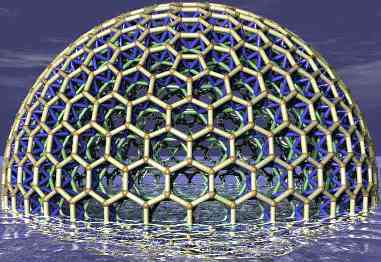
HexDome
Hexagonal Geodesic Domes - Dome Optimisation
Optimisation
Geodesic domes are a type of optimal structure -
the natural result of approaches involving minimising
material costs - while maximising either enclosed areas or
volumes.
Because of this optimality, it makes some sense to try
designing domes by building a model of the dome in a virutal
world - and then using classical optimisation techniques
to iteratively adjust the model until it maximises some
specified "dome desirability" function.
This approach seems likely to lead to domes which depart
from the classical polyhedral regularity of many geodesic
domes.
Several factors seem likely to lead real domes away
from classical polyhedra:
- Domes cope well with irregular ground:
- Deviations here can impact the shape, strut sizes
and topology of the dome.
- Struts in domes have to support more weight at the bottom:
- The increased number of struts towards the base of domes
is no match for the increased weight they have to support.
Adjustment in strut diameter is one possibility, but there
may be constraints on the available materials which make
this challenging. However, strut lengths could be varied -
so structural material became more concentrated lower in the
dome.
- Struts in domes have to support more weight at the bottom:
- The increased number of struts towards the base of domes
is no match for the increased weight they have to support.
Adjustment in strut diameter is one possibility, but there
may be constraints on the available materials which make
this challenging. However, strut lengths could be varied -
so structural material became more concentrated lower in the
dome.
- Domes are not full spheres - instead they meet the ground:
- Domes need entrances, fire escapes, and ventilation:
- The need for entrances and exits of particular sizes can
naturally deform the desired shape of the resulting dome.
Building a realistic model
For the results of optimisation techniques to be
applicable to the real world, a realistic model
needs to be constructed. This should simulate as
many aspects of the real dome as possible.
Real world domes need to resist impact forces,
withstand high winds, endure adverse weather
conditions - while remaining cost effective.
Optimisation techniques
There are a number of optimisation techniques available.
- Genetic algorithms;
- Simulated annealing;
While - in principle - genetic algorithms are much more
flexible, initially, we expect to be exploring simulated
annealing as a method of generating optimal domes.
Annealing domes
Currently, our simulated domes are formed by a technique
involving packing slowly-inflating balloons around a
sphere under pressure.
By a process of automated gradual "chilling" of the
system, we hope that this approch will be capable of
doing a good job of avoiding getting stuck in local
minima.
Tim Tyler |
Contact |
http://hexdome.com/
|